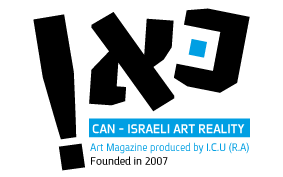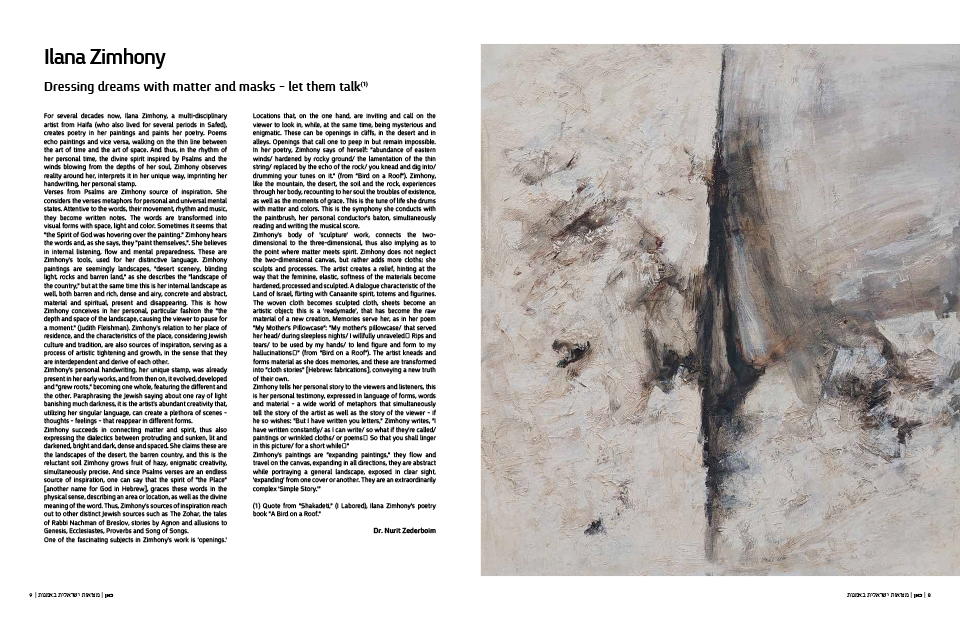
| Home Page | Editor Notices | Museums | Galleries | Publication | Donation | Contact Us |


 | |||||||||||||||
| |||||||||||||||


| |||||||||||||||
| Ilana Zimhony |
For several decades now, Ilana Zimhony, a multi-disciplinary artist from Haifa (who also lived for several periods in Safed), creates poetry in her paintings and paints her poetry. Poems echo paintings and vice versa, walking on the thin line between the art of time and the art of space. And thus, in the rhythm of her personal time, the divine spirit inspired by Psalms and the winds blowing from the depths of her soul, Zimhony observes reality around her, interprets it in her unique way, imprinting her handwriting, her personal stamp. Verses from Psalms are Zimhony source of inspiration. She considers the verses metaphors for personal and universal mental states. Attentive to the words, their movement, rhythm and music, they become written notes. The words are transformed into visual forms with space, light and color. Sometimes it seems that "the Spirit of God was hovering over the painting." Zimhony hears the words and, as she says, they "paint themselves,". She believes in internal listening, flow and mental preparedness. These are Zimhony's tools, used for her distinctive language. Zimhony paintings are seemingly landscapes, "desert scenery, blinding light, rocks and barren land," as she describes the "landscape of the country," but at the same time this is her internal landscape as well, both barren and rich, dense and airy, concrete and abstract, material and spiritual, present and disappearing. This is how Zimhony conceives in her personal, particular fashion the "the depth and space of the landscape, causing the viewer to pause for a moment." (Judith Fleishman). Zimhony's relation to her place of residence, and the characteristics of the place, considering Jewish culture and tradition, are also sources of inspiration, serving as a process of artistic tightening and growth, in the sense that they are interdependent and derive of each other. Zimhony's personal handwriting, her unique stamp, was already present in her early works, and from then on, it evolved, developed and "grew roots," becoming one whole, featuring the different and the other. Paraphrasing the Jewish saying about one ray of light banishing much darkness, it is the artist's abundant creativity that, utilizing her singular language, can create a plethora of scenes – thoughts – feelings – that reappear in different forms. Zimhony succeeds in connecting matter and spirit, thus also expressing the dialectics between protruding and sunken, lit and darkened, bright and dark, dense and spaced. She claims these are the landscapes of the desert, the barren country, and this is the reluctant soil Zimhony grows fruit of hazy, enigmatic creativity, simultaneously precise. And since Psalms verses are an endless source of inspiration, one can say that the spirit of "the Place" [another name for God in Hebrew], graces these words in the physical sense, describing an area or location, as well as the divine meaning of the word. Thus, Zimhony's sources of inspiration reach out to other distinct Jewish sources such as The Zohar, the tales of Rabbi Nachman of Breslov, stories by Agnon and allusions to Genesis, Ecclesiastes, Proverbs and Song of Songs. One of the fascinating subjects in Zimhony's work is 'openings.' Locations that, on the one hand, are inviting and call on the viewer to look in, while, at the same time, being mysterious and enigmatic. These can be openings in cliffs, in the desert and in alleys. Openings that call one to peep in but remain impossible. In her poetry, Zimhony says of herself: "abundance of eastern winds/ hardened by rocky ground/ the lamentation of the thin string/ replaced by the echo of the rock/ you knead and dig into/ drumming your tunes on it." (from "Bird on a Roof"). Zimhony, like the mountain, the desert, the soil and the rock, experiences through her body, recounting to her soul the troubles of existence, as well as the moments of grace. This is the tune of life she drums with matter and colors. This is the symphony she conducts with the paintbrush, her personal conductor's baton, simultaneously reading and writing the musical score. Zimhony's body of 'sculpture' work, connects the two-dimensional to the three-dimensional, thus also implying as to the point where matter meets spirit. Zimhony does not neglect the two-dimensional canvas, but rather adds more cloths; she sculpts and processes. The artist creates a relief, hinting at the way that the feminine, elastic, softness of the materials become hardened, processed and sculpted. A dialogue characteristic of the Land of Israel, flirting with Canaanite spirit, totems and figurines. The woven cloth becomes sculpted cloth, sheets become an artistic object; this is a 'readymade', that has become the raw material of a new creation. Memories serve her, as in her poem "My Mother's Pillowcase": "My mother's pillowcase/ that served her head/ during sleepless nights/ I willfully unraveled… Rips and tears/ to be used by my hands/ to lend figure and form to my hallucinations…" (from "Bird on a Roof"). The artist kneads and forms material as she does memories, and these are transformed into "cloth stories" [Hebrew: fabrications], conveying a new truth of their own. Zimhony tells her personal story to the viewers and listeners, this is her personal testimony, expressed in language of forms, words and material – a wide world of metaphors that simultaneously tell the story of the artist as well as the story of the viewer – if he so wishes: "But I have written you letters," Zimhony writes, "I have written constantly/ as I can write/ so what if they're called/ paintings or wrinkled cloths/ or poems… So that you shall linger in this picture/ for a short while…" Zimhony's paintings are "expanding paintings," they flow and travel on the canvas, expanding in all directions, they are abstract while portraying a general landscape, exposed in clear sight, 'expanding' from one cover or another. They are an extraordinarily complex 'Simple Story.'" (1) Quote from "Shakadeti," (I Labored), Ilana Zimhony's poetry book "A Bird on a Roof." Dr. Nurit Zederboim Read more  |
| all rights reserved - CAN ISRAELI ART REALITY |
| סייבורג מחשבים - בניית אתרים |